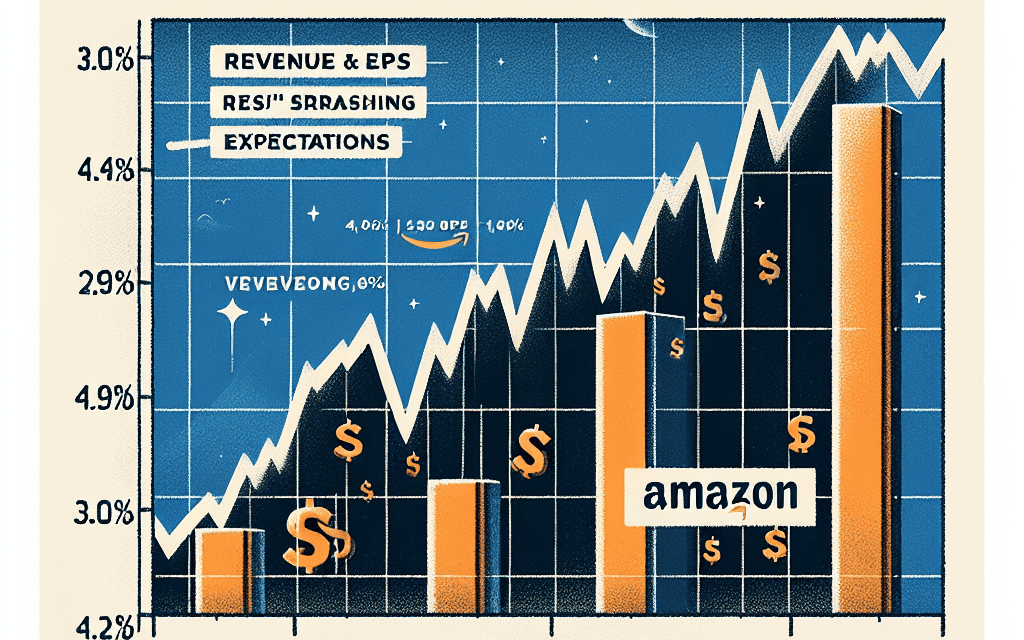“Amazon Soars: Revenue and EPS Exceed Expectations, Boosting After-Hours Stock Surge!”
Introduction
Amazon’s stock experienced a notable increase in after-hours trading following the release of its latest financial results, which exceeded market expectations. The e-commerce giant reported higher-than-anticipated revenue and earnings per share (EPS), driven by robust performance across its diverse business segments. This positive financial outcome highlights Amazon’s continued growth and resilience in a competitive market, reinforcing investor confidence and contributing to the surge in its stock price. The company’s ability to surpass Wall Street forecasts underscores its strategic initiatives and operational efficiency, positioning it favorably for future expansion.
Amazon’s Impressive Earnings: A Deep Dive into Revenue and EPS Surpassing Expectations
Amazon’s recent financial performance has captured the attention of investors and analysts alike, as the company’s stock experienced a notable rise in after-hours trading. This surge was primarily driven by Amazon’s impressive earnings report, which revealed that both revenue and earnings per share (EPS) had surpassed market expectations. As we delve deeper into the factors contributing to this financial success, it becomes evident that Amazon’s strategic initiatives and operational efficiencies have played a crucial role in achieving these remarkable results.
To begin with, Amazon’s revenue growth can be attributed to several key factors. The company’s e-commerce segment, which has long been its cornerstone, continued to demonstrate robust performance. Despite the challenges posed by global economic uncertainties and shifting consumer behaviors, Amazon managed to maintain its competitive edge by leveraging its vast logistics network and customer-centric approach. This allowed the company to efficiently meet the demands of its diverse customer base, thereby driving substantial revenue growth.
In addition to its e-commerce prowess, Amazon’s cloud computing division, Amazon Web Services (AWS), has emerged as a significant contributor to the company’s overall financial success. AWS has consistently been a leader in the cloud computing industry, offering a wide range of services that cater to businesses of all sizes. The division’s strong performance in the recent quarter can be attributed to the increasing demand for cloud solutions, as more companies seek to enhance their digital infrastructure and capabilities. This trend has been further accelerated by the ongoing digital transformation across various industries, positioning AWS as a key growth driver for Amazon.
Moreover, Amazon’s focus on innovation and diversification has also played a pivotal role in its impressive earnings. The company’s investments in emerging technologies, such as artificial intelligence and machine learning, have not only enhanced its operational efficiencies but also opened new avenues for revenue generation. For instance, Amazon’s foray into the healthcare sector, through initiatives like Amazon Pharmacy and partnerships with healthcare providers, has expanded its market reach and created additional revenue streams.
Furthermore, Amazon’s ability to adapt to changing market dynamics and consumer preferences has been instrumental in its financial success. The company’s strategic decision to expand its subscription services, such as Amazon Prime, has resulted in a steady increase in membership numbers. This, in turn, has contributed to higher customer retention rates and increased spending on the platform. Additionally, Amazon’s emphasis on enhancing the customer experience, through initiatives like faster delivery options and personalized recommendations, has further solidified its position as a leader in the retail industry.
As we consider the implications of Amazon’s impressive earnings, it is important to acknowledge the challenges that lie ahead. The company operates in a highly competitive and rapidly evolving market, where technological advancements and regulatory changes can significantly impact its operations. However, Amazon’s strong financial performance and strategic initiatives provide a solid foundation for continued growth and success.
In conclusion, Amazon’s recent earnings report highlights the company’s ability to surpass market expectations in terms of revenue and EPS. Through a combination of strategic investments, operational efficiencies, and a customer-centric approach, Amazon has managed to navigate the complexities of the global market and deliver impressive financial results. As the company continues to innovate and expand its offerings, it remains well-positioned to capitalize on emerging opportunities and maintain its leadership position in the industry.
After-Hours Trading Surge: Analyzing Amazon’s Stock Performance
In the realm of after-hours trading, Amazon’s stock performance has recently captured significant attention, as the company reported financial results that exceeded market expectations. This surge in stock value can be attributed to Amazon’s impressive revenue and earnings per share (EPS) figures, which have outperformed analysts’ forecasts. As investors and market analysts delve into the details, it becomes evident that several factors have contributed to this positive financial outcome, thereby influencing the after-hours trading surge.
To begin with, Amazon’s revenue growth has been a key driver of its stock performance. The company reported a substantial increase in revenue, which not only surpassed Wall Street’s predictions but also demonstrated Amazon’s robust business model and its ability to adapt to changing market conditions. This growth can be attributed to the company’s diverse range of services and products, which continue to attract a broad customer base. Moreover, Amazon’s strategic investments in technology and infrastructure have enabled it to enhance its operational efficiency, thereby contributing to its revenue growth.
In addition to revenue, Amazon’s EPS figures have also played a crucial role in boosting investor confidence. The company’s EPS exceeded expectations, reflecting its strong profitability and effective cost management strategies. This achievement is particularly noteworthy given the challenging economic environment and the competitive pressures faced by the retail and technology sectors. By maintaining a focus on cost control and operational excellence, Amazon has managed to deliver impressive financial results, which have, in turn, positively impacted its stock performance.
Furthermore, Amazon’s success in its cloud computing division, Amazon Web Services (AWS), has been a significant contributor to its overall financial performance. AWS continues to be a major growth driver for the company, with its revenue and profitability consistently on the rise. The increasing demand for cloud services, driven by the digital transformation of businesses worldwide, has positioned AWS as a leader in the industry. This success has not only bolstered Amazon’s financial results but has also reinforced investor confidence in the company’s long-term growth prospects.
Another factor that has contributed to Amazon’s stock surge is its ability to innovate and expand into new markets. The company’s foray into areas such as artificial intelligence, logistics, and entertainment has opened up new revenue streams and diversified its business portfolio. These strategic initiatives have allowed Amazon to stay ahead of the competition and maintain its position as a market leader. As a result, investors are optimistic about the company’s future growth potential, which is reflected in the after-hours trading surge.
Moreover, Amazon’s commitment to sustainability and corporate social responsibility has also played a role in enhancing its brand image and attracting socially conscious investors. The company’s efforts to reduce its carbon footprint and invest in renewable energy projects have resonated with stakeholders, further boosting its stock performance.
In conclusion, Amazon’s impressive financial results, driven by strong revenue growth, robust EPS figures, and successful strategic initiatives, have led to a significant rise in its stock value during after-hours trading. The company’s ability to innovate, expand into new markets, and maintain operational excellence has reinforced investor confidence and positioned it for continued success. As Amazon continues to navigate the complexities of the global market, its stock performance remains a focal point for investors seeking to capitalize on its growth potential.
Key Factors Behind Amazon’s Revenue Growth and EPS Success
Amazon’s recent financial performance has captured the attention of investors and analysts alike, as the company’s stock experienced a notable rise in after-hours trading. This surge was primarily driven by Amazon’s impressive revenue growth and earnings per share (EPS) that surpassed market expectations. To understand the key factors behind this success, it is essential to delve into the various elements that contributed to Amazon’s robust financial results.
One of the primary drivers of Amazon’s revenue growth is its continued dominance in the e-commerce sector. The company has consistently expanded its product offerings and improved its logistics network, enabling it to cater to a broader customer base. This expansion has been complemented by strategic pricing and promotional strategies, which have attracted more consumers to its platform. Furthermore, Amazon’s Prime membership program has played a crucial role in fostering customer loyalty and increasing purchase frequency, thereby boosting overall sales.
In addition to its e-commerce prowess, Amazon’s cloud computing division, Amazon Web Services (AWS), has been a significant contributor to its revenue growth. AWS has maintained its position as a leader in the cloud services market, offering a wide range of solutions that cater to businesses of all sizes. The increasing demand for cloud-based services, driven by digital transformation initiatives across various industries, has resulted in substantial revenue gains for AWS. This growth has been further bolstered by Amazon’s continuous investment in expanding its cloud infrastructure and enhancing its service offerings.
Moreover, Amazon’s focus on innovation and technology has been instrumental in driving its financial success. The company has consistently invested in research and development to introduce new products and services that meet evolving consumer needs. For instance, Amazon’s advancements in artificial intelligence and machine learning have not only improved its operational efficiency but also enhanced customer experiences through personalized recommendations and seamless interactions. These technological innovations have provided Amazon with a competitive edge, enabling it to capture a larger market share and drive revenue growth.
Another factor contributing to Amazon’s impressive financial performance is its strategic acquisitions and partnerships. By acquiring companies that complement its existing business lines, Amazon has been able to diversify its revenue streams and enter new markets. These acquisitions have also facilitated the integration of new technologies and capabilities, further strengthening Amazon’s market position. Additionally, strategic partnerships with other industry leaders have allowed Amazon to leverage synergies and expand its reach, ultimately contributing to its revenue and EPS growth.
Furthermore, Amazon’s ability to adapt to changing market conditions has been a key factor in its success. The company has demonstrated resilience in navigating challenges such as supply chain disruptions and regulatory pressures. By implementing agile strategies and optimizing its operations, Amazon has managed to maintain its growth trajectory and deliver strong financial results. This adaptability has instilled confidence among investors, contributing to the positive sentiment surrounding its stock performance.
In conclusion, Amazon’s recent rise in stock value following its revenue and EPS surpassing expectations can be attributed to a combination of factors. The company’s dominance in e-commerce, the success of AWS, a focus on innovation, strategic acquisitions and partnerships, and its adaptability to market changes have all played pivotal roles in driving its financial success. As Amazon continues to leverage these strengths, it is well-positioned to sustain its growth momentum and deliver value to its shareholders in the future.
Investor Reactions: How Amazon’s Earnings Beat Influenced Market Sentiment

Amazon’s recent earnings report has sparked significant interest among investors, as the company’s stock experienced a notable rise in after-hours trading. This surge can be attributed to Amazon’s impressive performance, which exceeded market expectations in both revenue and earnings per share (EPS). As investors digested the news, market sentiment shifted, reflecting a renewed confidence in the company’s strategic direction and operational efficiency.
To begin with, Amazon’s revenue figures were a key driver of the positive market reaction. The company reported a substantial increase in revenue, surpassing analysts’ forecasts. This growth was largely fueled by robust sales in its core e-commerce business, as well as continued expansion in its cloud computing division, Amazon Web Services (AWS). The latter has been a significant contributor to Amazon’s profitability, and its strong performance in the latest quarter underscored the company’s ability to capitalize on the growing demand for cloud services. Consequently, investors viewed these results as a testament to Amazon’s diversified business model and its capacity to generate sustainable growth across multiple sectors.
In addition to revenue, Amazon’s EPS also exceeded expectations, further bolstering investor confidence. The company’s ability to deliver higher-than-anticipated earnings was attributed to effective cost management and operational efficiencies. By optimizing its supply chain and leveraging technology to streamline operations, Amazon was able to enhance its profit margins despite the challenging economic environment. This achievement resonated with investors, who recognized the company’s adeptness at navigating complex market dynamics while maintaining a focus on long-term profitability.
Moreover, the positive earnings report had a ripple effect on market sentiment, influencing not only Amazon’s stock but also the broader technology sector. As one of the largest and most influential companies in the world, Amazon’s performance is often seen as a bellwether for the tech industry. Therefore, its earnings beat provided a sense of reassurance to investors, who had been wary of potential headwinds facing the sector. This renewed optimism was reflected in the upward movement of other tech stocks, as market participants anticipated similar positive outcomes from upcoming earnings reports.
Furthermore, the market’s reaction to Amazon’s earnings was not solely based on financial metrics. Investors also took note of the company’s strategic initiatives and future growth prospects. Amazon’s continued investment in areas such as artificial intelligence, logistics, and entertainment signaled its commitment to innovation and market leadership. These initiatives are expected to drive future growth and create new revenue streams, thereby enhancing the company’s competitive position. As a result, investors were encouraged by Amazon’s forward-looking approach and its potential to deliver sustained value over the long term.
In conclusion, Amazon’s earnings beat had a profound impact on market sentiment, as evidenced by the rise in its stock price after hours. The company’s strong revenue and EPS performance, coupled with its strategic initiatives, instilled confidence among investors and reinforced its status as a market leader. As the tech sector continues to evolve, Amazon’s ability to adapt and thrive in a dynamic environment will be closely watched by market participants. Ultimately, the positive investor reaction to Amazon’s earnings underscores the importance of exceeding expectations and maintaining a clear vision for future growth.
Comparing Amazon’s Financial Performance with Industry Peers
Amazon’s recent financial performance has captured the attention of investors and analysts alike, as the company’s stock experienced a notable rise in after-hours trading. This surge was primarily driven by Amazon’s ability to surpass market expectations in both revenue and earnings per share (EPS). As we delve into a comparative analysis of Amazon’s financial performance relative to its industry peers, it becomes evident that the company’s strategic initiatives and operational efficiencies have played a pivotal role in its success.
To begin with, Amazon’s revenue growth has consistently outpaced that of many of its competitors in the e-commerce and technology sectors. In the most recent quarter, Amazon reported a revenue increase that exceeded analysts’ forecasts, highlighting its robust business model and diversified revenue streams. This growth can be attributed to several factors, including the expansion of its Prime membership program, the continued success of its cloud computing division, Amazon Web Services (AWS), and its foray into new markets such as healthcare and advertising. In contrast, some of Amazon’s industry peers have struggled to maintain similar growth trajectories, often facing challenges related to market saturation and increased competition.
Moreover, Amazon’s EPS performance further underscores its financial strength. By delivering earnings that surpassed expectations, Amazon has demonstrated its ability to effectively manage costs and optimize its operations. This achievement is particularly noteworthy when compared to other major players in the industry, who have faced margin pressures and rising operational expenses. Amazon’s focus on innovation and automation has enabled it to streamline processes and enhance productivity, thereby contributing to its superior EPS results.
In addition to revenue and EPS, Amazon’s investment in technology and infrastructure has set it apart from its peers. The company’s commitment to research and development has resulted in cutting-edge advancements, such as artificial intelligence and machine learning, which have been integrated into various aspects of its business. These technological innovations have not only improved customer experience but have also provided Amazon with a competitive edge in the marketplace. While other companies in the sector are also investing in technology, Amazon’s scale and scope of innovation remain unparalleled.
Furthermore, Amazon’s global reach and adaptability have allowed it to capitalize on emerging opportunities in international markets. The company’s strategic acquisitions and partnerships have facilitated its entry into new regions, thereby diversifying its revenue base and reducing reliance on any single market. This global perspective contrasts with some of its industry peers, who may have a more limited international presence and face challenges in expanding beyond their domestic markets.
In conclusion, Amazon’s recent financial performance, characterized by its ability to exceed revenue and EPS expectations, highlights its position as a leader in the industry. Through strategic initiatives, technological innovation, and global expansion, Amazon has distinguished itself from its peers, many of whom continue to grapple with various challenges. As the company continues to evolve and adapt to changing market dynamics, its financial success serves as a testament to its resilience and forward-thinking approach. Investors and analysts will undoubtedly keep a close watch on Amazon’s future endeavors, as it seeks to maintain its competitive advantage and drive sustained growth in an ever-evolving landscape.
Future Outlook: What Amazon’s Earnings Mean for Long-Term Investors
Amazon’s recent earnings report has sparked significant interest among long-term investors, as the company’s stock experienced a notable rise in after-hours trading. This surge was primarily driven by Amazon’s ability to surpass both revenue and earnings per share (EPS) expectations, signaling a robust performance that has implications for its future trajectory. As investors digest these results, it is crucial to consider what this means for Amazon’s long-term prospects and how it might influence investment strategies moving forward.
To begin with, Amazon’s ability to exceed market expectations underscores its resilience and adaptability in a rapidly changing economic landscape. The company’s diverse business model, which spans e-commerce, cloud computing, digital streaming, and artificial intelligence, provides a solid foundation for sustained growth. This diversification not only mitigates risks associated with any single sector but also positions Amazon to capitalize on emerging opportunities across various industries. Consequently, long-term investors may view Amazon’s recent performance as a testament to its strategic foresight and operational excellence.
Moreover, the impressive earnings report highlights Amazon’s continued dominance in the cloud computing sector through Amazon Web Services (AWS). AWS remains a significant revenue driver, contributing substantially to the company’s overall profitability. As businesses increasingly migrate to cloud-based solutions, AWS is poised to maintain its leadership position, offering scalable and innovative services that cater to a wide range of clients. This ongoing expansion in cloud computing is likely to be a key factor in Amazon’s long-term growth strategy, providing a steady stream of revenue that supports its broader ambitions.
In addition to its cloud computing prowess, Amazon’s e-commerce segment continues to thrive, benefiting from a strong logistics network and a customer-centric approach. The company’s investment in technology and infrastructure has enhanced its ability to deliver products efficiently, thereby strengthening customer loyalty and expanding its market share. As consumer preferences evolve, Amazon’s commitment to innovation and service excellence will be instrumental in maintaining its competitive edge. For long-term investors, this focus on customer satisfaction and operational efficiency is a promising indicator of sustained success.
Furthermore, Amazon’s strategic investments in emerging technologies such as artificial intelligence and machine learning are likely to yield significant dividends in the future. These technologies not only enhance operational efficiencies but also enable Amazon to offer personalized experiences to its customers, thereby driving engagement and retention. As these technologies continue to mature, they will play an increasingly vital role in shaping Amazon’s product offerings and business strategies, further solidifying its position as a market leader.
While Amazon’s recent earnings report paints a positive picture, it is essential for long-term investors to remain cognizant of potential challenges. Regulatory scrutiny, competitive pressures, and macroeconomic uncertainties are factors that could impact Amazon’s growth trajectory. However, the company’s track record of navigating complex environments and its commitment to innovation provide a degree of confidence in its ability to overcome these hurdles.
In conclusion, Amazon’s ability to surpass revenue and EPS expectations in its latest earnings report bodes well for its long-term prospects. The company’s diversified business model, leadership in cloud computing, strong e-commerce performance, and strategic investments in emerging technologies position it favorably for sustained growth. While challenges remain, Amazon’s resilience and adaptability make it an attractive option for long-term investors seeking exposure to a dynamic and forward-thinking company. As the market continues to evolve, Amazon’s strategic initiatives and operational strengths are likely to drive its success in the years to come.
The Role of E-commerce and Cloud Services in Amazon’s Financial Success
Amazon’s recent financial performance has once again captured the attention of investors and analysts alike, as the company’s stock experienced a notable rise in after-hours trading. This surge was primarily driven by Amazon’s impressive revenue and earnings per share (EPS) figures, which surpassed market expectations. To understand the underlying factors contributing to this financial success, it is essential to examine the pivotal roles played by Amazon’s e-commerce and cloud services divisions.
E-commerce has long been the cornerstone of Amazon’s business model, and its continued growth is a testament to the company’s ability to adapt and innovate in a highly competitive market. The convenience and efficiency of online shopping have become increasingly appealing to consumers, particularly in the wake of the global pandemic, which accelerated the shift from brick-and-mortar stores to digital platforms. Amazon’s vast product selection, competitive pricing, and robust logistics network have positioned it as a leader in the e-commerce space, enabling the company to capture a significant share of the market. Furthermore, Amazon’s commitment to enhancing the customer experience through initiatives such as same-day delivery and personalized recommendations has further solidified its dominance.
In addition to its e-commerce prowess, Amazon’s cloud computing division, Amazon Web Services (AWS), has emerged as a critical driver of the company’s financial success. AWS has consistently demonstrated strong growth, contributing significantly to Amazon’s overall revenue and profitability. The increasing demand for cloud services across various industries has fueled AWS’s expansion, as businesses seek scalable and cost-effective solutions to manage their IT infrastructure. AWS’s comprehensive suite of services, ranging from computing power and storage to machine learning and artificial intelligence, has attracted a diverse clientele, including startups, large enterprises, and government agencies. This broad customer base has enabled AWS to maintain its position as a leader in the cloud computing market, further bolstering Amazon’s financial performance.
Moreover, the synergy between Amazon’s e-commerce and cloud services divisions has created a powerful ecosystem that drives innovation and efficiency. The data generated from e-commerce transactions provides valuable insights that can be leveraged to enhance AWS’s offerings, while the scalability and reliability of AWS’s infrastructure support the seamless operation of Amazon’s e-commerce platform. This interconnectedness not only strengthens Amazon’s competitive advantage but also fosters a culture of continuous improvement and adaptation.
As Amazon continues to expand its e-commerce and cloud services operations, the company is also exploring new avenues for growth. Initiatives such as the development of cashier-less stores, investments in renewable energy, and the expansion of its advertising business demonstrate Amazon’s commitment to diversifying its revenue streams and staying ahead of industry trends. These strategic moves are likely to further enhance Amazon’s financial performance and solidify its position as a global leader in both e-commerce and cloud computing.
In conclusion, Amazon’s recent financial success can be attributed to the significant contributions of its e-commerce and cloud services divisions. The company’s ability to innovate and adapt in these areas has not only driven revenue and EPS growth but also positioned Amazon as a formidable force in the digital economy. As the company continues to explore new opportunities and expand its offerings, it is well-poised to maintain its trajectory of financial success and deliver value to its shareholders.
Q&A
1. **What caused Amazon’s stock to rise after hours?**
Amazon’s stock rose after hours due to the company surpassing revenue and earnings per share (EPS) expectations.
2. **What were the revenue expectations for Amazon?**
Analysts had set specific revenue expectations, which Amazon exceeded, leading to the stock rise.
3. **How did Amazon’s EPS compare to expectations?**
Amazon’s EPS was higher than what analysts had predicted, contributing to the positive market reaction.
4. **What impact did the earnings report have on investor sentiment?**
The earnings report positively impacted investor sentiment, as evidenced by the after-hours stock price increase.
5. **Were there any specific business segments that performed particularly well?**
Certain business segments, such as AWS or e-commerce, may have outperformed, driving overall results.
6. **How did Amazon’s performance compare to previous quarters?**
Amazon’s performance showed improvement compared to previous quarters, reflecting growth and operational efficiency.
7. **What are analysts saying about Amazon’s future prospects following the earnings report?**
Analysts are likely optimistic about Amazon’s future prospects, given the strong earnings report and market reaction.
Conclusion
Amazon’s stock experienced an increase in after-hours trading following the release of its financial results, which exceeded market expectations in terms of both revenue and earnings per share (EPS). This positive performance indicates strong operational execution and effective cost management, contributing to investor confidence. The company’s ability to surpass forecasts suggests robust consumer demand and successful strategic initiatives, reinforcing its position as a leading player in the e-commerce and cloud computing sectors. As a result, the market’s optimistic response reflects anticipation of continued growth and profitability for Amazon.





